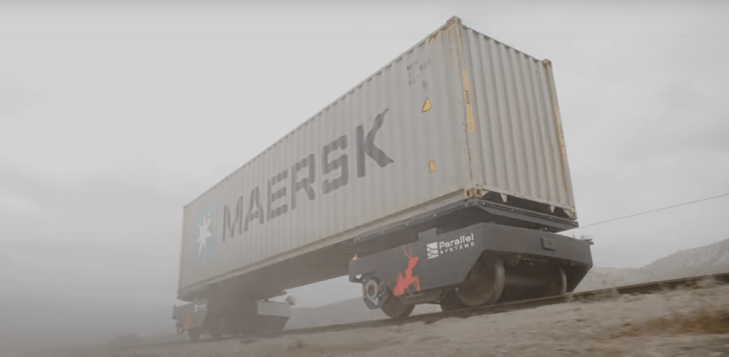Parallel Systems, a company founded by three former SpaceX engineers to build autonomous battery-electric rail vehicles, came out of stealth mode on Wednesday with a $49.55 million Series A raise. The company, which has raised $53.15 million to date, including a $3.6 million seed round, is working to create a more efficient, decarbonized freight network that flows on top of existing railway infrastructure.
The funds will be used to build Parallel System’s second-generation vehicle and launch an advanced testing program that will help the startup figure out how to integrate its vehicles into real-world operations, according to co-founder and CEO Matt Soule.
Parallel Systems also intends to use the new investment — which was led by Anthos Capital and includes investments from Congruent Ventures, Riot Ventures, Embark Ventures and others — to hire about 60 engineers, most of whom will deal with software, says Soule.
The startup’s rail vehicle architecture aims to solve a few problems: carbon emissions in freight, supply chain constraints of trucking and limits of railway freight. In the U.S., rail network accounts for 28% of all freight movement, but most of that is bulk movement activity — large trains that move primary resources like coal and lumber. A smaller portion of rail freight movement is referred to as intermodal activity, which essentially involves moving steel containers between a range of different modes of transportation, like boats and trucks.
“Rail has a lot of opportunity to grow when it comes to intermodal, and we focus on this because this is where we think there’s competition and appetite for innovation,” Soule told TechCrunch.
Parallel’s patent-pending vehicle architecture involves individually powered railcars that can load and transport standard shipping containers as a single or double-stacked load. They can join up to form “platoons” or split off to multiple destinations while en route, which means they don’t need to hold large volumes of freight to make the service economical, although Soule says they can actually carry much more weight than trucks, which handle most freight transportation in the U.S.
“For the unit economics of freight trains to get competitive with trucks, you need really long trains, and you’re amortizing the cost of that locomotive and crew over that one really long train,” said Soule. “When that becomes a problem is when you’re figuring out where to park that big train, and the answer is, not many places.”
Relying on long trains to transport goods means it’s harder to do high-volume turnovers that handle all our e-commerce wonders because those trains can’t always access urban communities or ports. They require specially built, large terminals to accommodate their physical size, said Soule.
“Our unit economics don’t depend on a very big train,” said Soule. “We can move in smaller platoons and rather than dwelling all day for the unloading and loading operation, we’re in and out within an hour or two, leaving room for other platoons to come in. It’s the more efficient footprint and it enables things like serving ports and creating inland port shuttle systems so you can move the containers from a seaport to an inland port, which is often a better place for trucks to go and are closer to warehousing activities.”
When it comes to autonomy, Parallel sees the railroad’s closed network as the ideal operational design domain for safe and early commercialization of autonomous technology due to limited track access and centralized traffic control. It’s important to note, however, that while Parallel’s long-term vision seems promising, the company has yet to test on national networks — it has been testing its prototype vehicle on a small rail in Los Angeles that’s insulated from national networks.
Rail in the U.S. is privately owned by owner-operators, which makes it difficult for Parallel to test its vehicles and the autonomous systems running the vehicles on a large scale. Parallel is targeting private rail companies as its customers, hoping to sell or lease its tools for them to operate the service on a day-to-day basis while offering a supporting role in terms of providing and integrating the technology. Until the startup gets a legacy railroad partner on board, it won’t be able to see if its tech can handle real-world operations.
The early-stage company is a few years off from developing tech that could go to market, says Soule, but it has an opportunity to own this sector of the market, particularly as shippers around the world not only want faster freight, but also cleaner freight.
The company’s platoon technology features self-propelled rail cars that push against each other to distribute the load, which, the company predicts, will lead to Parallel vehicles using just 25% of the energy compared to a semi-truck.
“The fundamental reason we’re doing this is to accelerate the decarbonization of freight, but the problem that we see is rail’s scale of operations is limited to a market it can serve,” said Soule. “So we’re trying to embrace this energy efficiency, but then break down its operational and economic barriers at the same time. And by the way, we’re making our powertrain electric, which further accelerates the decarbonization benefits because our grid itself is not clean. So when you look at a diesel truck, compared to what we’re building, and looking at the average, real-world CO2content of the U.S. grid, we’re going to be 90% less CO2 per mile to move a unit of freight with our technology versus a diesel truck today.”
